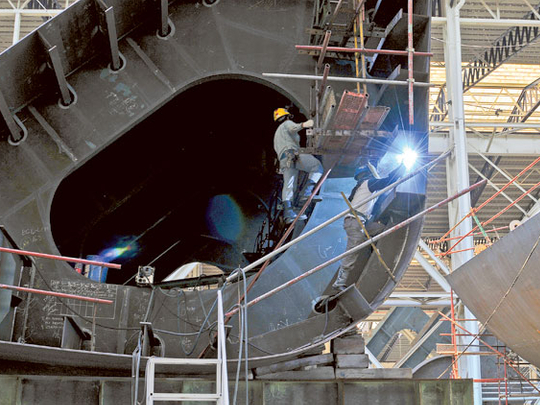
MANILA:Philippine growth cooled much more sharply than expected in the second quarter as exports slumped and the farm sector slowed, boosting expectations that the central bank and the government will take further action soon to cushion the economy from the global downturn.
The economy expanded just 0.2 per cent in the second quarter from the first three months of the year, dragged down by a slump in electronics exports and a related drop in industrial output, along with weaker growth in the agriculture and service sectors.
The growth rate was the weakest since the first quarter of 2009, highlighting the tremendous pressure building on export-reliant Asian economies from China and Japan to Southeast Asia to ramp up public spending or further ease monetary policy to shore up activity as the global malaise drags on.
“It’s clear that something really bad happened in the global economy in the second quarter and we’re seeing poor June and July numbers, especially for regional exports,” said ING economist Tim Condon.
“But if we look at first-half growth it was pretty solid ... I don’t think this (the Q2 number alone) indicates a structural hit to the Philippine growth story,” he said, adding it was difficult at first glance to determine a clear reason for the quarter’s marked weakness.
The economy could have contracted if not for a pick-up in consumer spending. Household consumption grew 1.4 percent in the quarter, accelerating from 0.9 percent in the first quarter thanks to strong remittances from Filipinos working overseas.
Manila is clearly counting on that consumer clout to help pull the economy out of its soft patch, or at least considerably soften the blow, but authorities say they won’t hesitate to offer further stimulus if conditions continue to deteriorate.
The government is ready to step up spending on public infrastructure to ensure growth this year will be closer to the high end of its target of 5 to 6 percent, Economic Planning Secretary Arsenio Balisacan told reporters after the GDP report.
Economists polled by Reuters had forecast the economy would grow 1.1 per cent in April-June from the previous quarter on a seasonally adjusted basis, slowing from an upwardly revised 3.0 per cent in the January-March quarter.
From a year earlier, the economy grew 5.9 per cent, the economic planning agency said on Thursday, faster than the 5.7 percent predicted by economists but cooler than a revised 6.3 per cent annual jump in the first quarter.
That brought growth in the first six months of the year to 6.1 per cent compared with the first half of 2011.
Despite the growing chill from the global slowdown, analysts still believe that much of Southeast Asia is better positioned to ride out global turmoil due to their large populations’ spending power, relatively low public and private sector debt and recent efforts to strengthen their financial systems.
In particular, analysts single out Indonesia and the Philippines as perhaps the most resilient economies in the region, followed by Malaysia and possibly Thailand.
Growth in both Indonesia and Malaysia surprisingly picked up in the second quarter to 6.4 per cent and 5.4 percent, respectively, year-on-year, though tiny, export-reliant Singapore, with no large consumer base, struggled to stay out of recession.
“For the rest of (Southeast Asia), especially for the open economies, they would probably be seeing a bit of a slowdown in the second half because exports have been increasingly weak,” said Euben Paracuelles, an economist at Nomura in Singapore.
“For the Philippines, this will also be the case but there’s a bigger offset from domestic demand because investment will hold up.”
Underlining the risks from the slowing global economy, the Bangko Sentral ng Pilipinas cut its key policy rate to a new low of 3.75 percent in July, the third reduction this year, and some economists expect another cut before year-end.
The central bank next meets on September 13.
The government’s budget deficit in the seven months to July was only 73.7 billion pesos, just around one-fourth of its full-year deficit target of 279 billion pesos, giving Manila more than enough room to increase spending for the rest of the year.
Exports, which account for about two-fifths of GDP, will remain the biggest downside risk for the economy in coming months.
In June, exports slowed sharply from a year earlier, as global demand sputtered, with electronics shipments declining for a third consecutive month.
That weighed heavily on industrial output, which fell a sharp 2.4 per cent in the second quarter from the first, when it grew 3.8 percent.
Agriculture and service sectors posted growth of 1.2 percent and 1.5 percent, respectively, but that rate was still much slower than recorded in the previous quarter.
The farm sector accounts for about one-fifth of the economy, and a series of severe storms which lashed the country in July and August could put further pressure on farm output.












